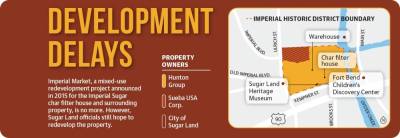The Imperial Market mixed-use project was announced in 2015 with plans including a cinema, a hotel, and retail and office space on the approximately 27-acre property off of Kempner Street. But it never materialized as developers for the project canceled their plans due to a lack of funding, city of Sugar Land officials said.
“You had a situation where they had the ability to build a mixed-use development of a very specific nature, and they couldn’t get the financing to do so,” Sugar Land Economic Development Director Elizabeth Huff said.
The sugar char house property remains vacant, and the new owner, Hunton Group, has presented no immediate redevelopment plans to the city of Sugar Land.
This comes after a 2020 structural engineering study on the char filter house, named for the bone charcoal used to filter impurities out of Imperial’s sugar, was conducted to gain further insight into the building’s condition. The study concluded entities such as the city and developers have about eight years before redevelopment or preservation are no longer feasible due to the building’s deteriorating condition.
“We wanted to be able to answer people’s questions because there was a lot of fear that it was going to fall down tomorrow,” Huff said.
Unease about the property comes due to its status for residents as a piece of history that was close to being redeveloped but never came to fruition.
Still, despite not owning the property, the city of Sugar Land continues to plan for redeveloping the land and is actively incentivizing development in that area.
Imperial Market no more
The Imperial Market name no longer exists for the city as it examines how best to redevelop the property.
The city of Sugar Land, which does not own the char house property, made the decision to rename the former Imperial Market land—which includes the char filter house and the area around it—as the Imperial Historic District in an effort to distance itself from the expectations and emotions tied to Imperial Market, Huff said.
The char house is on nearly 27 acres of land in the Imperial Historic District, which covers the sugar refinery site, land that spans from property on the east side of Oyster Creek, to the ChampionX chemical plant adjacent to Ulrich Street to the west and Mayfield Park to the north, Huff said.
Hunton Group owns the entire Imperial Historic District area minus buildings the city of Sugar Land owns, including the Sugar Land Heritage Museum and abandoned warehouse.
Former Imperial Market developers Jim Murnane and Geoff Jones intended to begin redeveloping the whole site in late 2015, but multiple delays occurred over the next three years before it was canceled altogether in 2018, Sugar Land officials said.
As longtime residents and community members watched plans for the Imperial Market disappear, frustration on the lack of progress still continues today, said Diana Rychlik, creator of Facebook group Save Imperial, which has more than 360 members focused on preserving the Imperial Sugar refinery through advocating for the property at City Council meetings and holding discussions with elected officials.
“I think a lot of people are upset and sad and angry at the way this process has come to pass and how long the building has been sitting there,” Rychlik said. “However, being upset and angry isn’t going to get us anywhere at this point.”
Looking back
Rychlik’s passion for the Imperial Sugar property comes after she spent her childhood in and around it, visiting her grandparents, Elvin and Martha Kocich, as they worked for Sugarland Industries, a company owned by Isaac H. Kempner’s family. The company supplemented Imperial Sugar Co. with stores, banks, farms and manufacturing prior to Imperial Sugar taking ownership in the early 1970s, Rychlik said.
The Kocichs worked for Imperial Sugar for more than 25 years with Rychlik growing up on what is referred to as The Hill, a span of several streets between First and Sixth streets that served as the original housing for the Imperial Sugar refinery employees during the early 1900s when Sugar Land was still a company town, a town whose inhabitants are mainly dependent on one company for employment, housing and supplies.
“We would walk there [to the factory], and I would bring my grandpa lunch. I have really, really good memories as a child growing up there,” she said.
The family was also there early in the morning in 2011 when the property owners at the time, Johnson Development, imploded several buildings, including the old sugar factory. Rychlik said she has waited ever since for that land to be redeveloped.
Residents feel so passionately about the Imperial Historic District because it all represents a fundamental piece of where Sugar Land came from, said Hal Jay, a volunteer docent for the Sugar Land Heritage Foundation.
From the early days of Sugar Land’s history as a company town, when residents worked for Imperial or Sugarland Industries, sugar is the continued bedrock of the city since its incorporation in 1959, Jay said.
“What built Sugar Land was the sugar industry, and the char house helped do that,” Jay said.
Ongoing efforts
Cost estimates place preserving the char house at about $15 million, while redeveloping could cost anywhere from $30 million-$50 million, Huff said.
However, how the char house and the rest of the Imperial Historic District will be redeveloped remains unclear, and requests for comment from the property owner of the char house, Hunton Group, went unanswered by press time.
“Not owning the property has been one of the hardest things to do because we really can’t do a lot to develop it,” said Suzanne Whatley, Sugar Land District 1 City Council member.
The city of Sugar Land did not pursue purchasing the land because that would require significant council action and a possible bond election to raise funds, Sugar Land Communications Director Doug Adolph said.
Instead, through its land use plan, the city of Sugar Land offers financial incentives for developers on properties such as the Imperial Historic District to encourage redevelopment, Huff said.
Those include grants, funding provided by tax increment reinvestment zones, and infrastructure reimbursement provided by the Imperial Redevelopment District, which comprises the Imperial Historic District and Constellation Field. The district issues bonds to finance eligible project costs in addition to establishing district property tax rates.
While the city of Sugar Land has no concrete plan, the historic property will be mixed use and have a level of office space, a level of retail and a residential component, Huff said.
The city included the Imperial Historic District in one of its list of greater regional activity centers, a hub of the city that attracts people from around the region. Uses for the property are specified in the city’s land use plan and enforced through zoning, Adolph said.
For residents such as Rychlik, something positive for the property rather than nothing at all would be a win for the community.
“It comes down to the owner and the city and the citizens figuring out how to compromise and find common ground to where we have the building saved and it’s not going to go to shambles in the next 10 years,” she said.
Redeveloping the historic district will require community engagement in the coming years, Huff said.
“Our goal is to be able to have a basic groundwork—a compelling project—that we can then take to the community and say, ‘Look how amazing this is. You’ve got to get behind it,’” Huff said. “We want that community support.”







